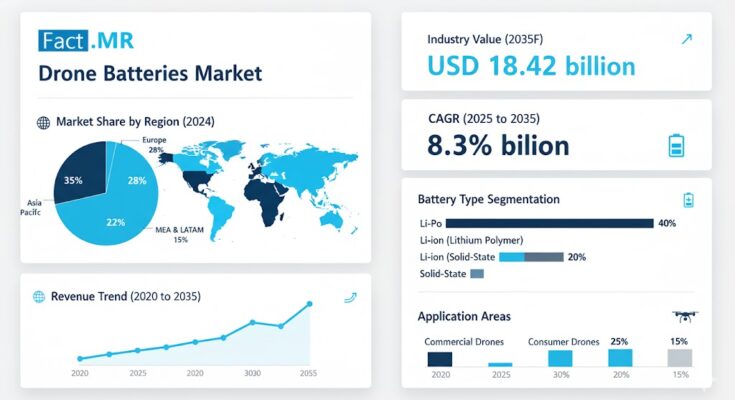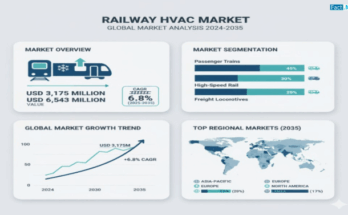The global drone batteries market is poised for rapid expansion as unmanned aerial vehicles (UAVs) continue to revolutionize multiple industries—from logistics and surveillance to agriculture and defense. According to a recent report by Fact.MR, the international drone batteries market, valued at USD 6.3 billion in 2022, is projected to grow at a compound annual growth rate (CAGR) of 8.3%, reaching USD 8.3 billion in 2025 and further escalating to USD 18.42 billion by 2035.
This impressive growth trajectory reflects the expanding integration of drones into business operations, military strategies, and consumer technology, alongside advancements in high-energy-density battery technologies.
Strategic Market Drivers
- Expanding Commercial and Industrial Applications
The global surge in drone deployment for logistics, mapping, inspection, and precision agriculture has significantly boosted the demand for advanced battery systems. Drone batteries are critical to ensuring longer flight durations, faster charging cycles, and enhanced payload capacities.
Commercial sectors such as construction, mining, real estate, and energy are increasingly using drones for site monitoring, asset inspection, and aerial surveys. This has spurred investments in lithium-polymer (LiPo) and lithium-ion (Li-ion) batteries that offer superior power-to-weight ratios and extended life cycles.
- Growing Military and Defense Utilization
Defense agencies across the globe are rapidly expanding their drone fleets for surveillance, reconnaissance, and tactical missions. The need for high-performance, long-endurance drones has accelerated research into lightweight, fast-charging, and thermally stable batteries.
Countries such as the United States, China, Israel, and India are at the forefront of integrating next-generation battery systems into defense-grade UAVs. Furthermore, growing investments in hybrid propulsion technologies are likely to extend operational ranges for combat and reconnaissance drones.
- Advancements in Battery Chemistry and Energy Density
Technological innovation in **battery chemistry—especially in lithium-sulfur (Li-S), solid-state, and graphene-based cells—**is creating new opportunities for the drone industry. These batteries provide higher energy density, enhanced safety, and faster charging, enabling longer and more efficient flight operations.
Manufacturers are increasingly focusing on developing smart battery management systems (BMS) that enhance power distribution, monitor performance in real time, and prevent overheating or short circuits, ensuring reliability in mission-critical applications.
Browse Full Report: https://www.factmr.com/report/1887/drone-batteries-market
Regional Growth Highlights
East Asia: Manufacturing and Innovation Hub
East Asia continues to dominate the drone batteries market, with China, Japan, and South Korea leading global production. The presence of major drone manufacturers such as DJI and Autel Robotics, coupled with robust electronics and materials industries, supports large-scale innovation and cost-effective production. Government initiatives promoting drone technology adoption in agriculture, logistics, and disaster management further reinforce regional growth.
North America: Driven by Defense and Commercial Expansion
North America remains a major revenue generator, supported by extensive military investments and rapid commercialization of drone-based services. The United States is a global leader in defense UAV technology, while industries like energy, media, and agriculture are leveraging drones for inspection and delivery operations. Continuous R&D funding in battery performance optimization, along with collaborations between defense contractors and battery developers, sustains regional dominance.
Europe: Sustainability and Technological Advancement
Europe’s focus on eco-friendly, high-performance batteries aligns with its sustainability goals. Nations like Germany, France, and the U.K. are investing in advanced drone systems for infrastructure monitoring, border surveillance, and environmental mapping. European manufacturers are prioritizing recyclable materials and low-emission production processes for drone batteries to comply with stringent EU environmental regulations.
Emerging Economies: Rapid Urbanization and Industrial Growth
Regions including South Asia, Latin America, and the Middle East are experiencing fast-growing demand for drones across infrastructure, agriculture, and security sectors. Rising government initiatives for smart cities, coupled with expanding defense budgets and agricultural automation, are expected to boost drone battery adoption.
Challenges and Market Considerations
Despite strong growth potential, the drone batteries market faces several challenges:
- Energy Density vs. Weight Trade-off: Balancing lightweight design with higher capacity remains a technological constraint.
- Thermal Management: High operating temperatures during extended flights can limit battery lifespan.
- Regulatory Hurdles: Drone operation restrictions and battery transport regulations may impact market growth.
- Raw Material Dependence: Lithium and cobalt supply chain risks influence battery pricing and availability.
Competitive Landscape
The drone batteries market is characterized by intense competition and technological innovation. Leading companies are focusing on product optimization, modular battery designs, and AI-integrated power management systems to enhance drone performance.
Key Companies Profiled:
- Amicell-Amit Industries Ltd.
- Amperex Technology Limited
- Autel Robotics Company
- Genspow GmbH
- Parrot
- Skydio
- SZ DJI Technology Co., Ltd.
- Uvify Inc.
- Venom Power
- Yuneec
- DJI Innovations
- Northrop Grumman (AeroVironment)
- FLIR Systems
- Intel Corporation
- Boeing (Insitu)
- Zipline International
These players are expanding manufacturing capacities, entering strategic collaborations, and investing heavily in next-generation energy solutions for drones.
Future Outlook: Toward Smarter, Safer, and Sustainable Drone Power
The coming decade will mark a major transformation in the drone batteries industry as manufacturers shift toward sustainable materials, AI-driven monitoring, and ultra-fast charging technologies. The rise of solid-state batteries and wireless charging platforms will redefine endurance and reliability standards for UAV operations.
As drones become integral to commercial logistics, defense intelligence, and urban mobility, the demand for high-performance, eco-efficient batteries will continue to rise. Companies that invest in innovation, sustainability, and global partnerships will lead the evolution toward the next generation of intelligent aerial power systems.



